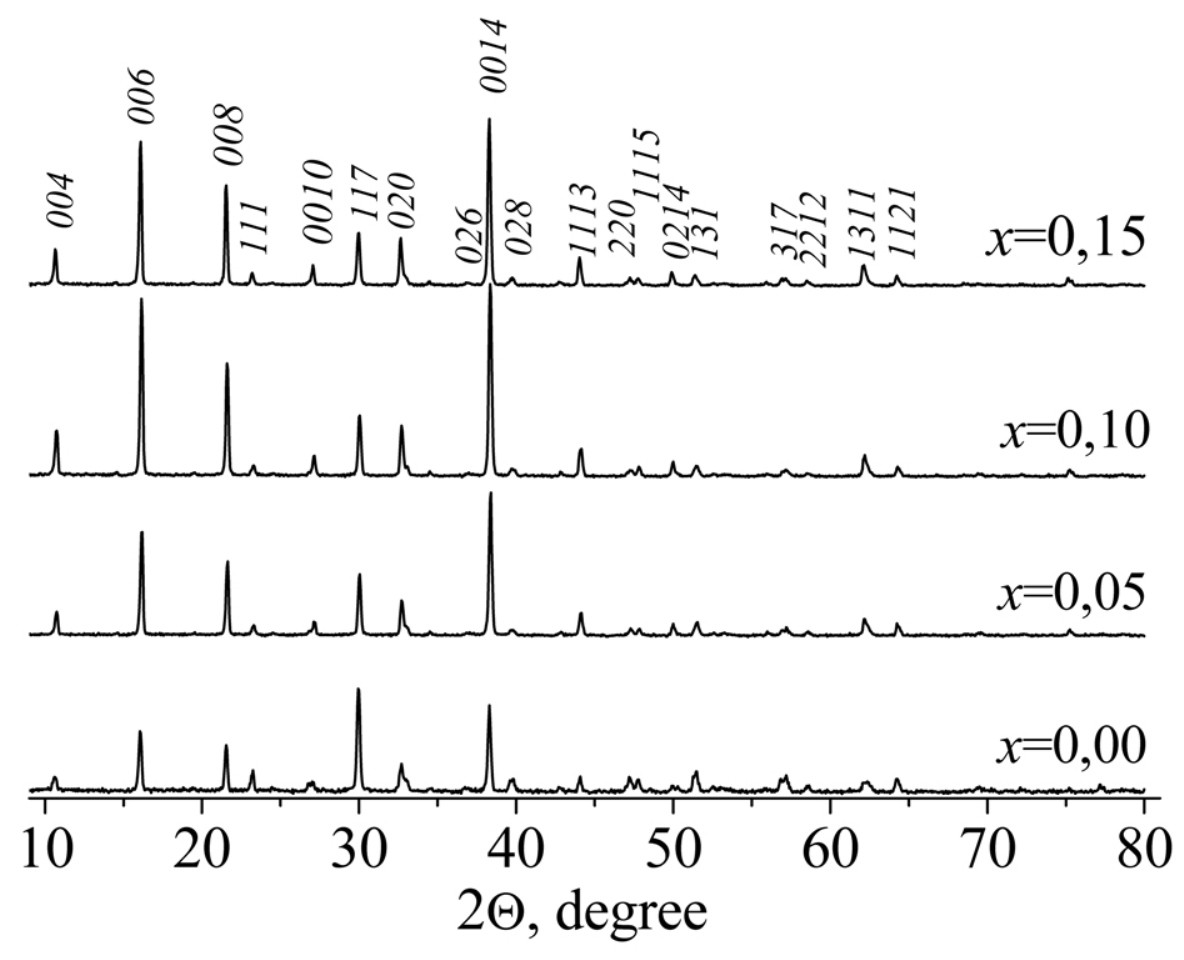
Preparation and characterization of Bi4–xPrxTi3O12 solid solutions
Abstract
The Bi4–xPrxTi3O12 (BPT) solid solutions (x = 0.05, 0.10, 0.15) with small praseodymium content were prepared by solid-state method. Thermal, electric, and dielectric properties of BPT were studied. It was revealed that BPT titanates crystalize in аn orthorhombic structure and exhibit p-type semiconductivity. Dielectric constant of BPT increased, Curie temperature (TC), electrical conductivity and dielectric losses decreased, but lattice parameters and thermo-EMF coefficient remained practically unchanged with the increase of praseodymium content in layered Bi4–xPrxTi3O12. It was determined that activation energy of direct current (DC) electrical conductivity and linear thermal expansion coefficient (LTEC) of BPT changes at ferroelectric (FE) → paraelectric (PE) phase transition. The activation energy and LTEC changed below and above TC from 1.08–1.56 eV to 0.45–0.86 eV and from (9.10–10.80)×10–6 K–1 to (13.12-14.61)×10–6 K–1, respectively. The AC electrical conductivity studies of BPT illustrated short-range order with ionic translations assisted by small-polaron hopping.
Keywords
Full Text:
PDFReferences
Hyatt NC, Hriljac JA, Comyn TP. Cation disorder in Bi2Ln2Ti3O12 Aurivillius phases (Ln = La, Pr, Nd and Sm). Mat Res Bull. 2003;38:837–46. doi:10.1016/S0025-5408(03)00032-1.
Scott JF, Araujo CA. Ferroelectric memories. Science. 1989;246(4936):1400–5. doi:10.1126/science.246.4936.1400
Park BH, Kang BS, Bu SD, Noh TW, Lee J, Jo W. Lanthanum-substituted bismuth titanate for use in non-volatile memories. Nature. 1999;401:682–4. doi:10.1038/44352
Wu D, Yang B, Li A. Structural phase transition due to La substitution in Bi4Ti3O12. Phase Transitions. 2009;82(2):146–55. doi:10.1080/01411590802524992
Pavlović N, Koval V, Dusza J, Srdić VV. Effect of Ce and La substitution on dielectric properties of bismuth titanate ceramics. Ceram Int. 2011;37:487–92. doi:10.1016/j.ceramint.2010.09.005
Klyndyuk AI, Glinskaya AA, Chizhova EA, Bashkirov LA. Synthesis and properties of lanthanum-substituted bismuth titanate with structure of Aurivillius phase. Refractories & Technical Сeramics. 2017;(1–2):29–33. Russian.
Kan YM, Zhang GJ, Wang PL, Cheng YB. Preparation and properties of neodymium-modified bismuth titanate ceramics. J Eur Ceram Soc. 2008;28:1641–7. doi:10.1016/j.jeurceramsoc.2007.10.010
Fortalnova EA, Politova ED, Ivanov SA, Safronenko MG. Phase formation and physicochemical properties of solid solutions Bi4–yTbyTi3O12 based on layered bismuth titanate. Russ J Inorg Chem. 2017;62(2):224–30. doi:10.1134/S0036023617020061
Klyndyuk AI, Chizhova EA. Structure, Thermal Expansion, and Electrical Properties of BiFeO3–NdMnO3 Solid Solutions. Inorg Mater. 2015;51(3):272–7. doi:10.1134/S0020168515020090
Villegas M, Jardiel T, Caballero AC, Fernandez JF. Electrical Properties of Bismuth Titanate Based Ceramics with Secondary Phases. J Electroceram. 2004;13:543–8. doi:10.1007/s10832-004-5155-2
Stojanović BD, Simoes AZ, Paiva-Santos CO, Quinelato C, Longo E, Varela JA. Effect of processing route on the phase formation and properties of Bi4Ti3O12 ceramics. Ceram Int. 2006;32:707–12. doi:10.1016/j.ceramint.2005.05.007
Shannon RD. Revised effective ionic radii and systematic studies of interatomic distances in halides and chalcogenides. Acta Cryst. 1976;A32:751–67. doi:10.1107/S0567739476001551
Chen Z, Yu Y, Hu J, Shui A, He X. Hydrothermal synthesis and characterization of Bi4Ti3O12 powders. J Ceram Soc Jap. 2009;117(3):264–7. doi:10.2109/jcersj2.117.264
Kim SK, Miyayama M, Yanagida H. Electrical anisotropy and a plausible explanation for dielectric anomaly of Bi4Ti3O12 single crystal. Mat Res Bull. 1996;31(1):121–31. doi:10.1016/0025-5408(95)00161-1
Kumar S, Varma KBR. Structural and dielectric properties of Bi4Ti2Nb0.5Fe0.5O12 ceramics. Solid State Commun. 2008;146:137–42. doi:10.1016/j.ssc.2008.02.004
Jimenez B, Jimenez R, Castro A, Millan P, Pardo L. Dielectric and mechanoelastic relaxations due to point defects in layered bismuth titanate ceramics. J Phys: Condens Matter. 2001;13(33):7315–26. doi:10.1088/0953-8984/13/33/312
Shashkov MS, Malyshkina OV, Piir IV, Koroleva MS. Dielectric properties of iron-containing bismuth titanate solid solutions with a layer perovskite structure. Phys Solid State. 2015;57(3):518–21. doi:10.1134/S1063783415030312
Kumari S, Ortega N, Kumar A, Pavunny SP, Hubbard JW, Rinaldi C, Srinivasan G, Scott JF, Katiyar RS. Dielectric anomalies due to grain boundary conduction in chemically substituted BiFeO3. J Appl Phys. 2015;117:114102. doi:10.1063/1.4915110
Jonscher AK. The ‘universal’ dielectric response. Nature. 1977;267:673–9. doi:10.1038/267673a0
Sadykov SA, Palchaev DK, Murlieva ZK, Alikhanov NM, Rabadanov MK, Gadzhimagomedov SK, Kallaev SN. AC conductivity of BiFeO3 ceramics obtained by spark plasma sintering of nanopowders. Phys Solid State. 2017;59(9):1771–7. doi:10.1134/S1063783417090268
DOI: https://doi.org/10.15826/chimtech/2017.4.4.01
Copyright (c) 2017 A. I. Klyndyuk, E. A. Chizhova, A. I. Poznyak

This work is licensed under a Creative Commons Attribution 4.0 International License.
Chimica Techno Acta, 2014–2025
eISSN 2411-1414
Copyright Notice







